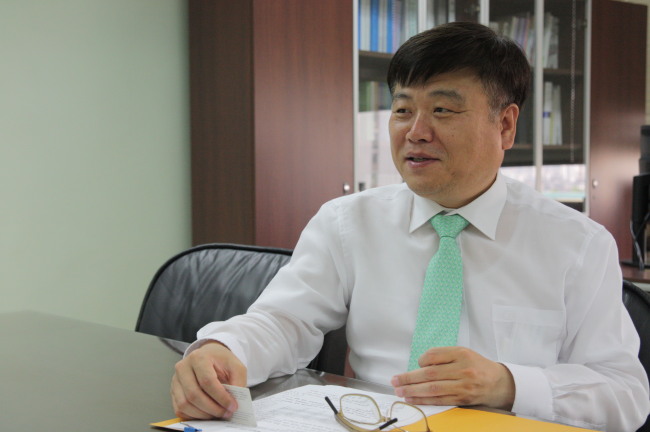In an exclusive interview, Park Min-ho said the 13.1 trillion won fund was biding time for the move, as conventional stock and bond investments generate lackluster returns.

“Many institutional investors turn to alternative investments now and the market has become more competitive. The remaining area (for profits) is hedge funds,” he said in his office in Seoul.
“We haven’t done any yet but we’re waiting for the right timing.”
The plan comes as National Pension Service, Korea’s largest investor with 524 trillion won under management, is preparing to put 1.2 trillion won into the asset class via two funds of hedge funds. It is to finalize fund selection by September.
Park also said the teachers’ fund would increase the proportion of its overseas investment to 20.9 percent this year from 17.6 percent in 2015 and bet more on low-cost index funds and passive exchange-traded funds in unpromising Korean stock markets.
Korea’s benchmark stock index KOSPI has failed to come out of a narrow range over the past five years. The index has been stuck between 1,800 and 2,100 since 2011, earning it the nickname “BOXPI.”
“So, we have to take more passive strategies than active ones within the local equities portfolio, to minimize the cost of trading,” he said, adding that passive ETFs would take up more than 10 percent of the local stock investment.
The pension fund’s financial asset pool has grown to 13.1 trillion won with the number of subscribers surpassing 300,000 as of the end of April. Korean teachers and clerical workers at private schools are obliged to subscribe to the Teachers’ Pension.
In terms of profitability, the pension did neither excellently nor poorly last year, Park said.
The fund’s annual return on assets was 3.7 percent in 2015 and the pension fund hopes to raise it to 4.6 percent this year.
To boost profitability of overseas stock investments, the Teachers’ Pension will also gradually reduce its currency hedging rate from the current 50 percent, according to Park.
The NPS, which did not do any currency hedging in overseas stock investment last year, reaped a 5.73 percent return thanks to the weak won against the dollar in 2015, while that of Teachers’ Pension was a meager 0.88 percent.
“We’re on a path to reducing currency hedging in overseas equities,” Park said.
Park, who joined the Teachers’ Pension in 2001 as head of its asset management division, said it was inefficient for the Teachers’ Pension to have its risk management team situated separately in Naju, South Jeolla Province. The team moved, along with the headquarters, in December 2014, as part of the government’s balanced regional development policy.
During the 2014 move to Naju, the government allowed only 45 employees to remain at the Seoul office – which resulted in a strange separation between fund managers in Seoul and risk managers in Naju, Park explained.
He mentioned another concern that the NPS’ planned move to Jeonju, North Jeolla Province, in February next year would reduce the opportunities for Teachers’ Pension staff to meet foreign asset management officials in Seoul.
“They will visit Jeonju, for sure, for the largest institutional investor NPS, and Sejong, where another large fund for the Korea Post is located. They might skip Seoul during their visit to Korea,” he said.
By Kim Yoon-mi (yoonmi@heraldcorp.com)
This is the second article in a series that introduces investment strategies of Korea’s largest pension and welfare funds. -- Ed.
-
Articles by Korea Herald


![[KH Explains] Why Korea's so tough on short selling](http://res.heraldm.com/phpwas/restmb_idxmake.php?idx=644&simg=/content/image/2024/05/19/20240519050115_0.jpg&u=20240520081646)
![[News Focus] Mystery deepens after hundreds of cat deaths in S. Korea](http://res.heraldm.com/phpwas/restmb_idxmake.php?idx=644&simg=/content/image/2024/05/17/20240517050800_0.jpg&u=)















![[Today’s K-pop] Seventeen to launch new subunit duo](http://res.heraldm.com/phpwas/restmb_idxmake.php?idx=642&simg=/content/image/2024/05/20/20240520050685_0.jpg&u=)